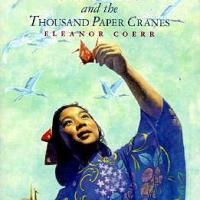
100 Paper Crane for Peace
The Story of Sadako and the Thousand Paper Cranes
August is a bittersweet month. It is the month in which we mournfully remember the atomic bombings of Hiroshima and Nagasaki on August 6 and August 9 during the final stages of World War II. The nuclear weapons, developed and deployed by the United States, brought complete obliteration to the two cities and killed approximately 200,000 Japanese from both immediate and long-term effects. Most of the Japanese who fell victim to the nuclear weapons were innocent civilians. The laws of war and ethical standards were shattered, and the United States set a precedent of nuclear proliferation. Yet, although August is the month in which we reflect on the horrors of Hiroshima and Nagasaki, it is also the month in which worldwide peace efforts that stemmed from such tragedy are celebrated. The story of Sadako Sasaki is one story that has inspired generations to pursue a peaceful and just world.
Sadako Sasaki was two-years-old when the world’s first atomic bomb dropped on Hiroshima, about two miles away from her home. Although many of her neighbors were killed instantaneously, Sadako survived the explosion, seemingly unscathed. However, below the surface and over the course of the next ten years, Sadako developed leukemia. Many other children who were exposed to radiation from the atomic bombs developed leukemia as well. In Japan, leukemia was known as “the A-bomb disease.” While hospitalized, Sadako began to make origami cranes. Ancient Japanese legend holds that anyone who folds one thousand paper cranes, senbazuru, will be granted a wish. Inspired by the Senbazuru legend, Sadako set out to fold one thousand cranes. She wrote, “I will write peace on your wings, and you will fly all over the world.” Sadako continued faithfully and persistently to create these symbolic birds until the disease claimed her life at age 12 on October 25, 1955.
Sadako’s story, however, remains very much alive. After her death, Sadako’s schoolmates began to fold paper cranes so as to continue her legacy, and Japanese school children raised funds to build the Children’s Peace Monument in Hiroshima Peace Memorial Park; on top of a three-legged pedestal stands the bronze figure of Sadako. With outstretched arms, Sadako holds a majestic, golden crane. At the base of the monument, on a black marble slab, a wish is inscribed, “This is our cry. This our prayer. Building peace in the world.” The monument not only commemorates Sadako and the thousands of other children who were victims of the Hiroshima atomic bombing, but symbolizes the hope for a brighter future. To this day, children from around the world send hand-folded paper cranes to be placed beneath Sadako and her golden crane. The crane is now internationally-recognized as a symbol of peace.
To commemorate the 67th anniversary of the atomic bombings of Hiroshima and Nagasaki, the Nuclear Age Peace Foundation will be hosting The 18th Annual Sadako Peace Day on Monday, August 6, 2012 at 6:00 pm. The ceremony will take place in the Sadako Peace Garden at the La Casa de Maria Retreat Center in Montecito, California and is free and open to the public. The featured speaker at the commemoration will be Kikuko Otake, who like Sadako, was a young girl when the atomic bomb was dropped on Hiroshima. She too lived only a little more than a mile away from the ground zero. Many of Kikuko’s close family members were killed in the bombing, but Kikuko managed to barely escape death. Kikuko is an award-winning poet and author of Masako’s Story: Surviving the Atomic Bombing of Hiroshima, which she will be signing copies of following the event. I invite you to join us at the commemoration.
Sadako Sasaki and Kikuko Otake were not and will not be the last to be victimized by nuclear war. Some victims have directly suffered from the effects of nuclear explosions; others live every day in fear of a nuclear threat from foreign and domestic governmental policies. I urge you to reflect during the month of August, and hopefully, for the rest of your life, on how you can help carry out the wish of Sadako’s paper cranes.








